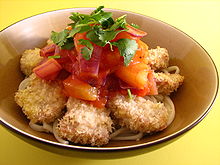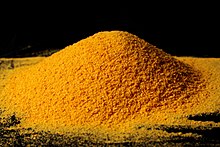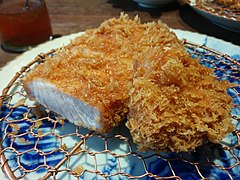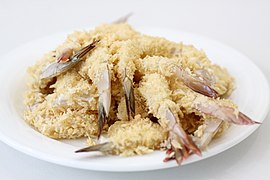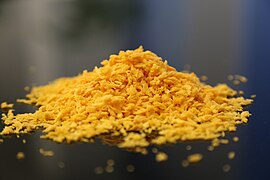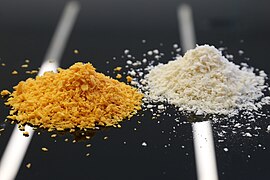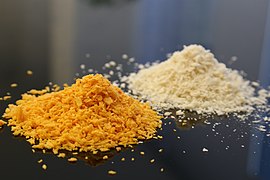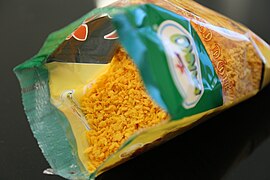
Bread is a staple food prepared from a dough of flour and water, usually by baking. Throughout recorded history and around the world, it has been an important part of many cultures' diet. It is one of the oldest human-made foods, having been of significance since the dawn of agriculture, and plays an essential role in both religious rituals and secular culture.
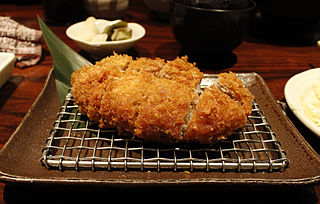
Tonkatsu is a Japanese dish that consists of a breaded, deep-fried pork cutlet. It involves coating slices of pork with panko, and then frying them in oil. The two main types are fillet and loin. Tonkatsu is also the basis of other dishes such as katsukarē and katsudon.

Tempura is a typical Japanese dish that usually consists of seafood and vegetables that have been coated in a thin batter and deep fried.

Cornbread is a quick bread made with cornmeal, associated with the cuisine of the Southern United States, with origins in Native American cuisine. It is an example of batter bread. Dumplings and pancakes made with finely ground cornmeal are staple foods of the Hopi people in Arizona. The Hidatsa people of the Upper Midwest call baked cornbread naktsi. Cherokee and Seneca tribes enrich the basic batter, adding chestnuts, sunflower seeds, apples, or berries, and sometimes combine it with beans or potatoes. Modern versions of cornbread are usually leavened by baking powder.

A crouton is a piece of toasted or fried bread, normally cubed and seasoned. Croutons are used to add texture and flavor to salads—notably the Caesar salad— as an accompaniment to soups and stews, or eaten as a snack food.

in Austria and the Swabian, Bavarian and Franconian parts of Germany, 'leverkaas' in the Netherlands and Fleischkäse ("meat-cheese") in Saarland, Baden, Switzerland and Tyrol) is a speciality food found in the south of Germany, in Austria and parts of Switzerland. It consists of beef, pork and bacon and is made by grinding the ingredients very finely and then baking it as a loaf in a bread pan until it has a crunchy brown crust. Variations may be made using other kinds of meat such as horse meat or turkey, or may contain additional ingredients such as cheese or minced chili peppers.
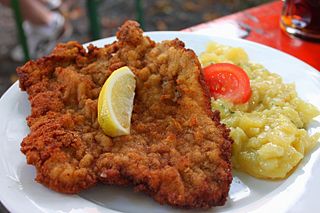
A schnitzel is a thin slice of meat. The meat is usually thinned by pounding with a meat tenderizer. Most commonly, the meat is breaded before frying. Breaded schnitzel is popular in many countries and is made using veal, pork, chicken, mutton, beef, or turkey. Schnitzel originates in Austria as wiener schnitzel and is very similar to dishes such as escalope in France and Spain, panado in Portugal, tonkatsu in Japan, cotoletta in Italy, kotlet schabowy in Poland, řízek in Czech Republic, milanesa in Latin America, chuleta valluna in Colombia, chicken chop in Malaysia, and chicken-fried steak and pork tenderloin of the United States.

The milanesa is a variation of the Lombard veal Milanese, or the Austrian Wiener schnitzel, where generic types of breaded cutlet preparations are known as a milanesa.
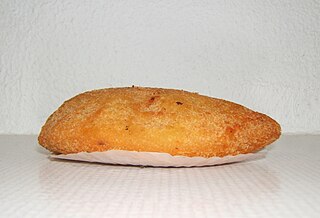
A rissole is a small patty enclosed in pastry or rolled in breadcrumbs, usually baked or deep fried. The filling has savory ingredients, most often minced meat, fish or cheese, and is served as an entrée, main course, or side dish.
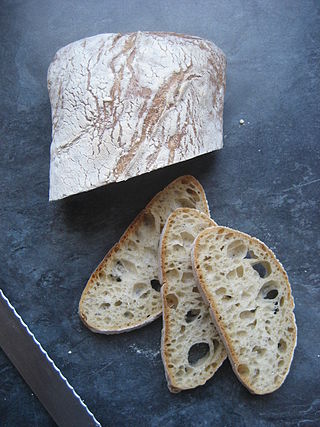
Ciabatta is an Italian white bread made from wheat flour, water, salt, yeast and olive oil, created in 1982 by a baker in Adria, province of Rovigo, Veneto, in response to the popularity of French baguettes. Ciabatta is somewhat elongated, broad, and flat, and is baked in many variations, although unique for its alveolar holes. Ciabatta is made with a strong flour and uses a very high hydration dough.
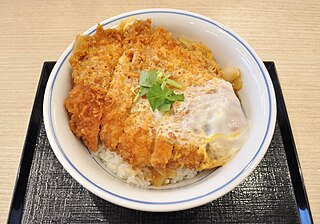
Katsudon is a popular Japanese food, a bowl of rice topped with a deep-fried breaded pork cutlet, egg, vegetables, and condiments.
Cutlet refers to:
- a thin slice of meat from the leg or ribs of mutton, veal, pork, or chicken
- a dish made of such slice, often breaded
- a croquette or cutlet-shaped patty made of ground meat
- a kind of fish cut where the fish is sliced perpendicular to the spine, rather than parallel ; often synonymous with steak
- a prawn or shrimp with its head and outer shell removed, leaving only the flesh and tail
- a mash of vegetables fried with bread
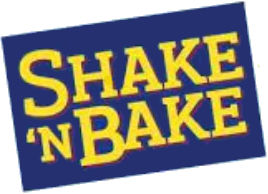
Shake 'n Bake is a seasoned bread crumb coating originally marketed to mimic the flavor and texture of Southern fried chicken. Introduced in 1965 by General Foods, it is currently made under the Kraft Heinz brand.

Menchi-katsu (メンチカツ) is a Japanese breaded and deep-fried ground meat patty; a fried meat cake. The meat is usually ground beef, pork, or a mixture of the two. It is often served in inexpensive bento and teishoku.

Stuffed peppers is a dish common in many cuisines. It consists of hollowed or halved bell peppers filled with any of a variety of fillings, often including meat, vegetables, cheese, rice, or sauce. The dish is usually assembled by filling the cavities of the peppers and then cooking.
Dredging is a cooking technique used to coat wet or moist foods with a dry ingredient prior to cooking. Put most simply, dredging involves little more than pulling or rolling the wet food through the dry material to provide an even coating. The technique is particularly common with breaded foods, such as fried fish or chicken cutlets.

A croquette is a deep-fried roll originating in French cuisine, consisting of a thick binder combined with a filling, which is then breaded. It is served as a side dish, a snack, or fast food worldwide.

Crispiness or crispness is one of the most common food texture attributes. Crispiness refers to a hard food that emits a sound upon fracturing. Foods described as crisp tend not to show signs of deformation prior to fracture. Crispiness and crunchiness are often used interchangeably, however crispiness tends to be associated with a higher pitched sound, while crunchiness is associated with lower pitched sounds.

Breaded cutlet or braised cutlet is a dish made from coating a cutlet of meat with breading or batter and either frying or baking it.

